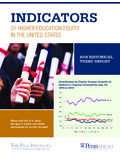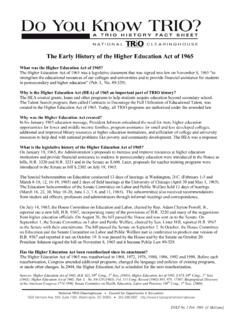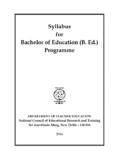Transcription of fact sheets-6-Year DAR for Students Post-Secondary ...
1 Pell Institute Fact Sheet Updated: 12/14/2011. 6- year DEGREE ATTAINMENT RATES FOR Students . ENROLLED IN A Post-Secondary INSTITUTION. Background/History There are many positive outcomes associated with graduating from college, including higher income and rates of employment. This fact sheet examines the 6- year degree attainment rates for Students that enrolled in any postsecondary institution in Fall 2003. The graduation rates are disaggregated by the following four categories: Pell Grant receipt, First-generation and low-income status, Family income, and Family income as a percent of the Federal poverty threshold. Overall, Only of Students enrolled in postsecondary education earned a bachelor 's degree within 6 years. of these Students earned an associate's degree or other credentials, were still enrolled and did not yet earn a degree, and left school without a degree and did not return.
2 Disaggregation of the data, however, reveals an even more disturbing picture. Each of the four charts below shows significant gaps in graduation rates by income. According to the data below, Students from low-income families are less likely to earn a bachelor 's degree within six years, compared to their more financially affluent peers. Data Source: 2003/04 Beginning Postsecondary Students Longitudinal Study, (BPS:04/09). bachelor 's degree completion rates by Pell grant status Attained Attained associate's Still Dropped bachelor 's degree or other enrolled out degree credentials Received Pell grant Did not receive Pell grant The Federal Pell Grant Program provides need-based grants to low-income undergraduate to promote access to postsecondary education. bachelor 's degree completion rates by first-generation and low-income status Attained Attained associate's degree Still Dropped bachelor 's or other credentials enrolled out degree Low-income, first-generation Low-income, not first-generation First-generation, not low-income Not low income and not first- generation Low-income is defined as the student's family income falling at or below $25,000.
3 First-generation is defined as Students who come from families where neither parent has earned a bachelor 's degree or higher. bachelor 's degree completion rates for by parental income Attained Attained associate's Still Dropped bachelor 's degree or other enrolled out degree credentials $0-$29,999 $30,000-$59,999 $60,000-$99,999 $100,000 and above bachelor 's degree completion rates by family income as a percent of the Federal poverty threshold Attained Attained associate's Still Dropped bachelor 's degree or other enrolled out degree credentials Less than 150% 151 to 200% 201% to 300% 301% and above According to the Census Bureau, the poverty threshold for 2003 was $ 18,660 for a two-adult, two-child family. A family is considered at the poverty threshold when its total income (before taxes and not including public housing, Medicaid, or food stamps).
4 Is less than the family's threshold. The official poverty threshold does not vary geographically and is updated annually for inflation. 150% of poverty is the eligibility cutoff for TRIO participatio














